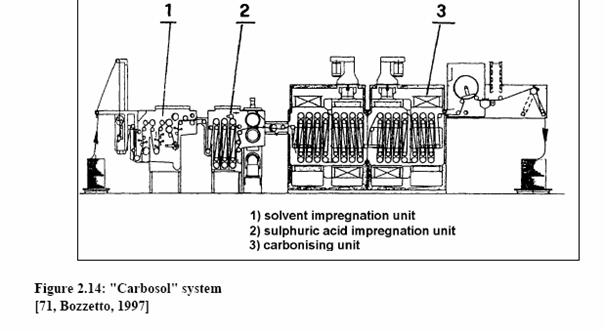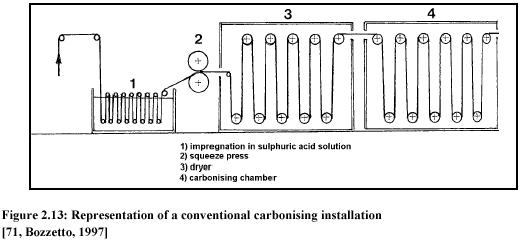Additional information to carbonizing of wool
Back to Carbonizing of wool
1. DESCRIPTION OF TECHNIQUES, METHODS AND EQUIPMENT
- Processing Stages
The conventional technique of wool carbonising has the following basic steps: a. Scouring of the raw wool with non-ionic detergent. b. Rinsing. c. Immersion in a long bowl containing 5-7% (w/v) sulphuric acid, 1-2 g/L detergent at 20-30oC. d. Double squeezing and/or continuous centrifuging prior to drying. e. Drying at 60-80oC to a low regain. f. Baking at 95-120oC to carbonise the VM. g. Pass through heavy fluted rollers to crush the embrittled VM. h. Convey to a rotating shaker/de-duster to remove the charred VM dust. i. Pass through a neutralising bowl usually containing sodium carbonate. j. Rinsing with a small addition of detergent. k. Bleaching with hydrogen peroxide at approximately pH 5 with formic acid. l. Final drying.
Source: wool carbonising pdf
Sometimes scoured wool contains vegetable impurities that cannot be completely removed through mechanical operations. Sulphuric acid is the chemical substance used for destroying these vegetable particles and the process is called carbonising.
Carbonising can be carried out on floc/loose fibres or fabric (this operation is not applied in the carpet sector).
Loose fibre carbonising is performed only on fibres that are later used to produce fine fabric for garments (worsted fabrics) and usually takes place at the scouring mill.
In typical equipment for carbonising of loose fibre, the still damp scoured wool is soaked in a solution containing 6 – 8- % of mineral acid (generally sulphuric acid). Excess acid and water are removed by pressing or by centrifugation until on average 5 – 7,5 % of sulphuric acid and 50 – 65 % of water remain. The fibres are then dried at 65 – 90 °C to concentrate the acid and baked at 105 – 130°C (carbonising).
As soon as the wool is dried, it is fed into a machine, which consists of two counter-rotating rolls. These rolls crush the carbonised particles into very small fragments, which are then easily removed. The addition of small quantities of detergent to the sulphuric acid improves the yield and reduces the attack on the wool. In order to prevent the fibre from being gradually degraded, the pH is finally set to 6 by neutralisation with sodium acetate or ammonia.
Sulphuric acid can be replaced by gaseous HCl or by aluminium chloride. The latter releases HCl when it is heated: this method is useful for the carbonisation of wool/synthetic fibres mixtures such as wool/PES that are too sensitive to sulphuric acid.
After carbonising, the fibre can be carded and then spun before being dyed or it can be dyed directly in floc form.
Fabric carbonising is typical of woollen fabrics. The operation can be carried out by either the traditional or the more modern “Carbosol” system.
The conventional procedure is substantially similar to that used for loosed fibre. The fabric can be previously soaked in a water or solvent bath and squeezed, but this step is optional. Then it is impregnated in a concentrated sulphuric acid solution (acidification) and squeezed (hydro extraction) before passing through the carbonising chamber. The carbonised particles are then removed by mechanical action and subsequent washing. In modern carbonising plants all these steps are carried out in a continuous mode.
The “Carbosol” process, licensed by SPEROTTO RIMAR, uses an organic solvent instead of water. The equipment consists of three units. In the first one the fabric is impregnated and scoured with perchloroethylene, in the second the material is soaked in the sulphuric acid solution and in the third, carbonising and solvent evaporation take place. At this stage the perchloroethylene is recovered by distillation in a closed loop.
The “Carbosol” system is reported to have several technical advantages over the traditional process. The level of acidity of the fabric after carbonising is much lower and the risk of damage to the wool fabric is reduced. Thanks to full recovery of the organic solvent, the process can be considered more efficient from the environmental point of view.
2. NEW TECHNOLOGIES
- a) Changes in the process
Very little in the way of research into the carbonising process has been conducted in more recent times. What work that has been done in the latter part of the 20th century is summarised below.
- Acidising
-Stainless steel replaces wood for bowl construction -Use of wetting agents to improve and even out uptake of acid -Alternative acids (aluminium chloride, HCl, thionyl chloride etc)
- Moisture removal
-High pressure squeezes -Double sets of squeeze rollers -Continuous centrifuges
- Drying/Baking
-Lower temperature drying preceding baking to minimise chemical damage -Moisture control systems for more even drying and energy conservation -Two stage baking -Intermediate crushing
- Burr crushing and dedusting
-Multiple stage crushing and step dedusting
- Neutralisation
-pH control -Alternative neutralising agents (eg ammonia, ammonium carbonate)
- b) Changes in the heat supply system
No information is available.
- c) Changes in the energy distribution system
No information is available.
Back to Carbonizing of wool

